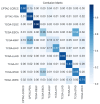Deep Attention Fusion Hashing (DAFH) Model for Medical Image Retrieval
- PMID: 39061755
- PMCID: PMC11273414
- DOI: 10.3390/bioengineering11070673
Deep Attention Fusion Hashing (DAFH) Model for Medical Image Retrieval
Abstract
In medical image retrieval, accurately retrieving relevant images significantly impacts clinical decision making and diagnostics. Traditional image-retrieval systems primarily rely on single-dimensional image data, while current deep-hashing methods are capable of learning complex feature representations. However, retrieval accuracy and efficiency are hindered by diverse modalities and limited sample sizes.
Objective: To address this, we propose a novel deep learning-based hashing model, the Deep Attention Fusion Hashing (DAFH) model, which integrates advanced attention mechanisms with medical imaging data.
Methods: The DAFH model enhances retrieval performance by integrating multi-modality medical imaging data and employing attention mechanisms to optimize the feature extraction process. Utilizing multimodal medical image data from the Cancer Imaging Archive (TCIA), this study constructed and trained a deep hashing network that achieves high-precision classification of various cancer types.
Results: At hash code lengths of 16, 32, and 48 bits, the model respectively attained Mean Average Precision (MAP@10) values of 0.711, 0.754, and 0.762, highlighting the potential and advantage of the DAFH model in medical image retrieval.
Conclusions: The DAFH model demonstrates significant improvements in the efficiency and accuracy of medical image retrieval, proving to be a valuable tool in clinical settings.
Keywords: deep hashing; deep learning; medical image retrieval.
Conflict of interest statement
The authors declare no conflicts of interest.
Figures
Similar articles
-
Deep hashing and attention mechanism-based image retrieval of osteosarcoma scans for diagnosis of bone cancer.J Bone Oncol. 2024 Nov 6;49:100645. doi: 10.1016/j.jbo.2024.100645. eCollection 2024 Dec. J Bone Oncol. 2024. PMID: 39624675 Free PMC article.
-
Enhanced Image Retrieval Using Multiscale Deep Feature Fusion in Supervised Hashing.J Imaging. 2025 Jan 12;11(1):20. doi: 10.3390/jimaging11010020. J Imaging. 2025. PMID: 39852333 Free PMC article.
-
Deep triplet hashing network for case-based medical image retrieval.Med Image Anal. 2021 Apr;69:101981. doi: 10.1016/j.media.2021.101981. Epub 2021 Feb 3. Med Image Anal. 2021. PMID: 33588123
-
Precision medical image hash retrieval by interpretability and feature fusion.Comput Methods Programs Biomed. 2022 Jul;222:106945. doi: 10.1016/j.cmpb.2022.106945. Epub 2022 Jun 15. Comput Methods Programs Biomed. 2022. PMID: 35749884
-
Hierarchical Recurrent Neural Hashing for Image Retrieval With Hierarchical Convolutional Features.IEEE Trans Image Process. 2018 Jan.;27(1):106-120. doi: 10.1109/TIP.2017.2755766. IEEE Trans Image Process. 2018. PMID: 28952940
References
Grants and funding
LinkOut - more resources
Full Text Sources




